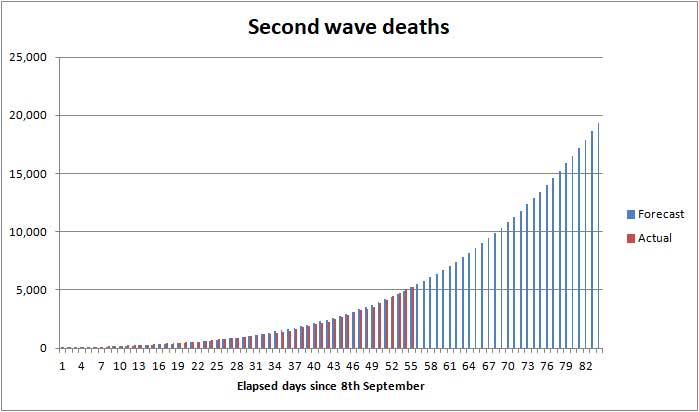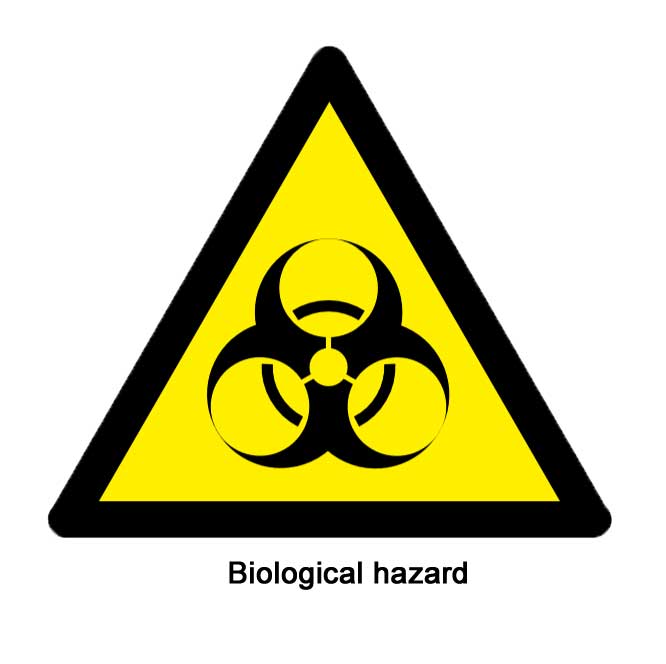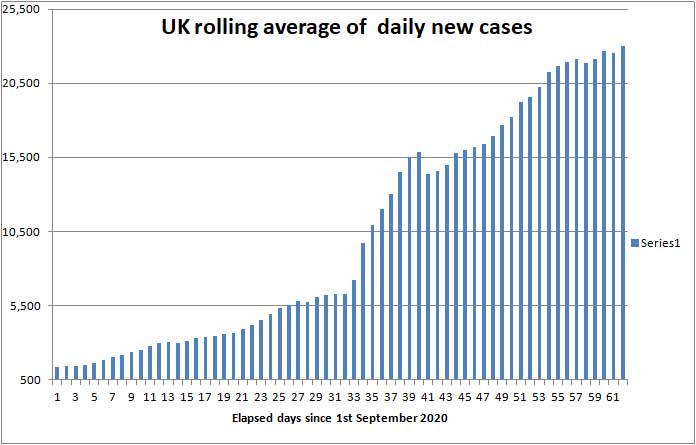
Angus and Rosemary's Miscellany
of Malvern - Other Resources
|
Coronavirus (COVID-19) epidemic weekly update for Malvern SeniorsCOVID LOCKDOWN Archived page 1st November 2020 Skip to menu of archived pages PreambleWe keep an eye on the published government figures to asses the level of risk in the Malvern Hills district, if there is an uptick in cases we will tell you.
|
| Districts of Worcs | Cases | Weekly increase | Population |
| Bromsgrove | 1,452 | +222 | 98,529 |
| Malvern Hills | 626 | +92 | 77,545 |
| Redditch | 1,016 | +184 | 85,317 |
| Worcester | 1,070 | +174 | 103,542 |
| Wychavon | 1,149 | +182 | 126,240 |
| Wyre Forest | 1,089 | +199 | 100,957 |
| TOTAL | 6,402 | +1,053 | 592,130 |
| COMPARE WITH | |||
| County of Hereford | 1,531 | +176 | 195,000 |
| Leicester (city of) | 11,170 | +1,332 | 400,000 |
Cumulative cases reported by PHE in Worcestershire to 1st November 2020
These numbers are high enough for Worcestershire to be placed into TIER 2 were it not for the national lockdown.
There could actually be double this number of cases if people were included who show no symptoms or have not been able to get a test.
Ninety two cases of COVID-19 were reported in the Malvern Hills compared to seventy eight last week.
The Coronavirus Dashboard has a new Interactive Map which is coloured to show the variation in infection rates across the country. The darkening colours show how the infection has continued to spread despite the present control measures.
You may need to click the 'Experimental Release' link on the main Dashboard page to find the map. If you keep clicking the plus sign (+) to enlarge the map eventually you will see for example areas of Malvern, Guarlford and Madresfield; if you click each of these a box pops up which shows the number of cases in the last reported seven days, and a rolling average normalised to 100,000 population per week so rates can be compared across the country.
Click for Interactive Map of COVID cases
Recent weekly cases have been Malvern Hills and Priory 5; North Malvern 8; Pickersleigh 7; Malvern Link 9; Callow End, Colletts Green and Hanley 7; Upton and Welland 7. The picture changes daily.
Number of deaths
Public Health England reports that the cumulative total of COVID (28) deaths in UK hospitals and care homes has risen by 1,821 this week to 46,717 while the rolling 7 day average has increased from 179 to 260 deaths per day; in comparison about 1,700 people die daily from natural causes.
Most COVID deaths are currently in the north of England and South Wales where infection rates are highest.
The Office of National Statistics (ONS) separately reports registered deaths in England and Wales where COVID-19 is mentioned on the death certificate. The ONS figures lag the PHE figures by about ten days and do not include NI and Scotland.
The cumulative total of COVID related deaths in Worcestershire reported by the ONS up to 16th October is shown below.
| Districts of Worcs | Deaths | Weekly increase | Population |
| Bromsgrove | 134 | 0 | 98,529 |
| Malvern Hills | 47 | 0 | 77,545 |
| Redditch | 60 | 0 | 85,317 |
| Worcester | 64 | 0 | 103,542 |
| Wychavon | 113 | 0 | 126,240 |
| Wyre Forest | 123 | +3 | 100,957 |
| TOTAL | 541 | +3 | 592,130 |
Cumulative COVID deaths registered by ONS to 16th October 2020
Click for national ONS data on deaths (Excel spreadsheet)
Click to view UK government Coronavirus Dashboard
In England and Wales 716 COVID related deaths were reported by ONS in the week to 16th October, an increase of 241 (50%) on the week before. Of these 109 were in Care Homes, 37 at home, and 560 in hospital. The highest number of hospital deaths by Lower Tier Local Authority were:
Stockton 6, Halton 6, Warrington 6, Nottingham 6, County Durham 6, Northumberland 12, West Lancashire 7, Wyre 7, Bury 7, Manchester 10, Oldham 6, Wigan 16, Knowsley 8, Liverpool 29, Sefton 14, Wirral 11, Newcastle 7, Sunderland 6, Birmingham 10, Bradford 10, Kirklees 8, Leeds 12, Wakefield 6, Redbridge 10, Rhondda Cynon Taf 10, Caerphilly 6, Aneurin Bevin University Health Board 10, Cwm Taf Morgannwg University Health Board 15.
The national COVID death rate can be expected to continue accelerating gently during November as those few patients unlucky enough to be severely affected by the second surge of the virus deteriorate. Little can be done to prevent these deaths as they relate to people who have already been infected. As Professor Van Tam says - 'they are baked in'.
However the death rate should begin falling in December as a result of the second national lockdown.
Healthcare
The UK government Coronavirus Dashboard includes information about COVID-19 patients in hospital.
| Hospital cases (UK) | Number | Weekly change |
| Patients in hospital | 10,918 | +3,068 |
| Patients on ventilation | 978 | +236 |
| Patients admitted daily | 1,442 | +300 |
Headline summary of patients in hospital as of 1st November 2020
Although these headline figures are not updated regularly they show a steady upward trend.
A particular figure to watch is the number of patients on ventilators; at the height of the epidemic in April the figure was 3,000. It should be noted that while 33% of ventilated beds across the country are now occupied, it is reported hospitals in Coronavirus hotspots in the NE, NW, and South Wales are already approaching capacity, and there is concern that all intensive care unit (ICU) beds in those areas could soon be filled. It is as a result of this concern the government has imposed a second lockdown in England as otherwise there might be little or no capacity to treat non COVID patients in a few weeks time.
There now seems some doubt about whether the Nightingale Hospitals at Manchester (NW), Sunderland (NE), and Harrogate (Yorkshire and the Humber) will be of much use due to a shortage of doctors and nurses.
Professor Peter Horby of Oxford University said on the Andrew Marr show that up to 20% of COVID patients in hospital could die. If this is correct, the current daily admission rate of 1,442 new patients suggests a ramp up to about 300 deaths per day is likely within the next 4 weeks.
COVID patients are said to arrive in hospital 7 to 10 days after first symptoms, and either die or are discharged 15 to 30 days after first symptoms in most cases.
Beds are occupied by suspected COVID patients, sick COVID patients, and some suffering from 'Long COVID' who may remain in hospital for much longer than 30 days.
Forecast for the week ahead
Trends suggest that during the next seven days the cumulative total of UK COVID-19 cases reported by PHE on the Coronavirus Dashboard can be expected to increase by approximately 175,000 towards 1,210,000 cases.
In Worcestershire 1,200 new cases of COVID-19 can be expected, and possibly up to 110 cases in the Malvern Hills district.
The number of COVID (28) deaths can be expected to increase by about 2,200 nationally towards 48,900.
In the county of Worcestershire, assuming a 2% death rate, the 1,053 new cases this week could translate to 21 Worcestershire deaths per week by the end of November, but if cases are confined to younger age groups it could be less.
Looking to the longer term, based on the present exponential trajectory, with deaths doubling every 2 weeks, we predict that in the worst case the national daily death rate could peak at up to 700 deaths per day by the end of November, but should then decline due to the second national lockdown.
During this 'blip' the storing of bodies in temporary mortuaries and some delay to funeral services should be expected between late November and early January when the seasonal death rate goes up.
Providing people act sensibly over Christmas, control measures ought to result in a reduction of new daily cases in December with a consequential gradual fall in the daily death rate in January 2021, by which time there is a slim chance the first vaccines may begin to come on stream for NHS staff, care workers, and the elderly.
The illustration below shows additional COVID deaths since 8th September in red and our latest (worst case) forecast of deaths in blue up to the end of November.

Revised forecast of second wave deaths to 30th November 2020
It is impossible to forecast further ahead as what happens during December will depend on the effectiveness of the second national lockdown which in turn will depend on the behavior of the public.
Advice for Seniors

The virus is spreading widely and there are pockets of infection across the Malvern Hills and Worcestershire; we consider the risk during the next week to be HIGH for Seniors living in the Malvern Hills district, who should therefore consider shielding depending on vulnerability and avoid contact with strangers; see our riskometer opposite.
The simple points to remember are:
to wash your hands thoroughly for 20 seconds, including after handling deliveries to your home (HANDS) see note 1;
wear a face mask when appropriate (FACE);
avoid mingling where possible, and continue with precautions such as physical distancing by 2 metres (SPACE) keeping social contact brief (TIME) see note 2.
Hence the mantra:-
HANDS, FACE, SPACE, TIME - GET A TEST if you feel unwell
click for UK government Coronavirus guidance on what you can and cannot do
Remember, if you have symptoms of COVID-19 and can't count from one to ten out loud due to shortness of breath, you should immediately call your GP, 111 or 999 for advice.
Notes:
1) Early on in the epidemic it was advised we should not touch our face to avoid transferring virus from our hands. Difficult to do, but this remains good practice in between washing hands.
2) Indoors with poor ventilation an invisible mist of virus can build up in the air which, unless you wear a hospital grade face mask, you will breath in should you be in such a space with an infected person. In this situation a face covering will offer little or no protection. The likelihood and extent you get sick will depend on the density of the airborne virus and your exposure time.
3) Because of the second lockdown the rule of six no longer applies. Subject to exceptions, you must not mix with other households until after 2nd December.
Annex to 1st November update
Commentary
BJ's government seems to be losing its grip, true or not. At the beginning of the Coronavirus epidemic the PM and Matt Hancock both emphasised they were following the science. On the 21st September they chose to ignore scientific advice recommending a two week Circuit Breaker over half term. Subsequently the PM told Sir Keir Starmer he was wrong in recommending a two week Circuit Break in October and targeted local lockdowns were the way to go. Given the patchy nature of infections the Chief Medical Officer appeared to concur.
At all times the government has had access to the figures and best specialist advice yet the PM appears surprised that hospitals are beginning to be flooded with COVID patients. Either he has been badly informed and his advisers need to be called to account or he is guilty of not keeping abreast of the situation.
The fault is not only with the government; it is clear that many people have not been following the guidance yet instead of enforcing measures the PM praises the public for doing so well. Local authorities appear complicit in not enforcing the regulations.
Spooked by the scientists the PM appears to have panicked executing yet another U turn by announcing a national lockdown despite his policy of tiered targeted lockdowns being in place for a only a few days, and the number of new daily cases appearing to approach a plateau.
Lack of leadership
Nicola Sturgeon briefs the Scottish public daily but where are our leaders? The PM rarely appears these days and Matt Hancock seems to have gone to ground. Matt has been doing a sterling job but has looked tired recently and perhaps a deputy should takeover while he has a rest.
As far as we know, Community leaders have not appeared in the media encouraging people to obey the rules and chastising those that do not.
Dido Harding who was appointed head of Test and Trace has not been briefing the public on where Test and Trace has been going wrong and what needs to be fixed. Pictures of her in the media towing a horse box don't give confidence she is on the case.
The PM trumpeted the creation of a Joint Biosecurity Centre, but as far as the public is concerned there is no evidence such a beast exists.
This and the debacle over free school meals makes us wonder whether the PM needs a more competent Press Officer?
Test and Trace
The media says Test and Trace has been performing poorly. Allegedly the Serco element is not providing a high percentage of test results within 24 hours and only about 50% of index cases are being contacted. From the start local Public Health Directors said they wanted to be involved but they weren't. It's still not clear what has been going wrong and whether it can be fixed. Perhaps the government should order an emergency audit of Test and Trace, for example by a team from the Defence Science and Technology Laboratory and Public Health Directors, if they have not already done so?
Effect on people and businesses
Just when people were getting back to near normal the government has ordered a second national lockdown. We wonder how the public will react second time around.
Because of the lockdown a couple are having their marriage arrangements cancelled for a third time in an area where there are few cases. Politicians need to have more concern about the effect of their actions on people's lives.
This government has crashed the economy, put people out of work, built up huge national debt and taken us out of the European Community. Given their inept handling of the COVID epidemic, businesses must be very concerned the same people are attempting to negotiate a trade deal with the EU.
School students and Christmas
Children and teenagers are to continue going to school so we'll have to wait and see to what extent they spread the virus reducing the effectiveness of the lockdown. Of course pupils must attend school, because another year group will be stepping up behind them.
One imagines the government for popularity reasons will want families to be able to mingle at Christmas, but if they are not careful much of the good work achieved during the lockdown could be undone.
Tony Blair interview on Sky TV
On Monday 2nd November Tony Blair outlined a way ahead and suggested four priorities.
1) Trialling vaccines in the wider population as soon as considered safe. They did not need to offer 100% protection from sickness at this stage and even 40% effectiveness should have a marked benefit when used in areas of highest infection.
2) Greater use of therapeutics such as the steroid Diamethasone, antivirals such as Remdesivir, and Monoclonal Antibody therapy such as manufactured by Regeneron.
3) Regular mass testing in schools and universities.
4) An integrated information system to bring all data together.
As Seniors, other than taking care, all we can do is wait and see how things pan out!
Summary of Links
Symptoms
Article about the effects of Coronavirus on the human body
Reporting and how to obtain a test
How to get a test
https://www.nhs.uk/coronavirus
About joining the Zoe COVID Symptom Study:
Guidance
UK government Coronavirus guidance
Statistics
UK government Coronavirus Dashboard
Coronavirus Dashboard Interactive map
ONS data on deaths in England and Wales (Excel spreadsheet)
Snapshots of deaths in hospital in England. This is not consolidated, so best see the Coronavirus Dashboard to view trends.
Reports
National COVID-19 surveillance reports
ONS Coronavirus (COVID-19) roundup: Deaths and health
The bigger picture
Worldometer summary of coronavirus cases worldwide
European Centre for Disease Prevention and Control info
https://www.ecdc.europa.eu/en/geographical-distribution-2019-ncov-cases
World Health Organisation info
Window on the USA
Centre for Disease Control (CDC)
American Association of Retired People (AARP)
Worcestershire
Help
http://www.worcestershire.gov.uk/here2help
Outbreak Control Plan
http://www.worcestershire.gov.uk/coronavirus
Miscellaneous
Spanish Flu
Dr Jeff Kildea's commentary about the 1919 outbreak of Spanish Flu in Australia
Views of Martin McKee, Professor of European Public Health
Follow Martin McKee on Twitter
SAGE membership
Scientific Advisory Group for Emergencies (SAGE)
Scottish government:
Link to Scottish Government website

The interpretations and opinions expressed are our own
Last updated 2nd November 2020
 Blogs
>
Blogs
> How
to request a test
How
to request a test Please
consider helping others by downloading the COVID Symptom Study app onto your
smart phone or Ipad and reporting how you feel either daily, or as you are
able. Note that currently there is no desktop PC version.
Please
consider helping others by downloading the COVID Symptom Study app onto your
smart phone or Ipad and reporting how you feel either daily, or as you are
able. Note that currently there is no desktop PC version.